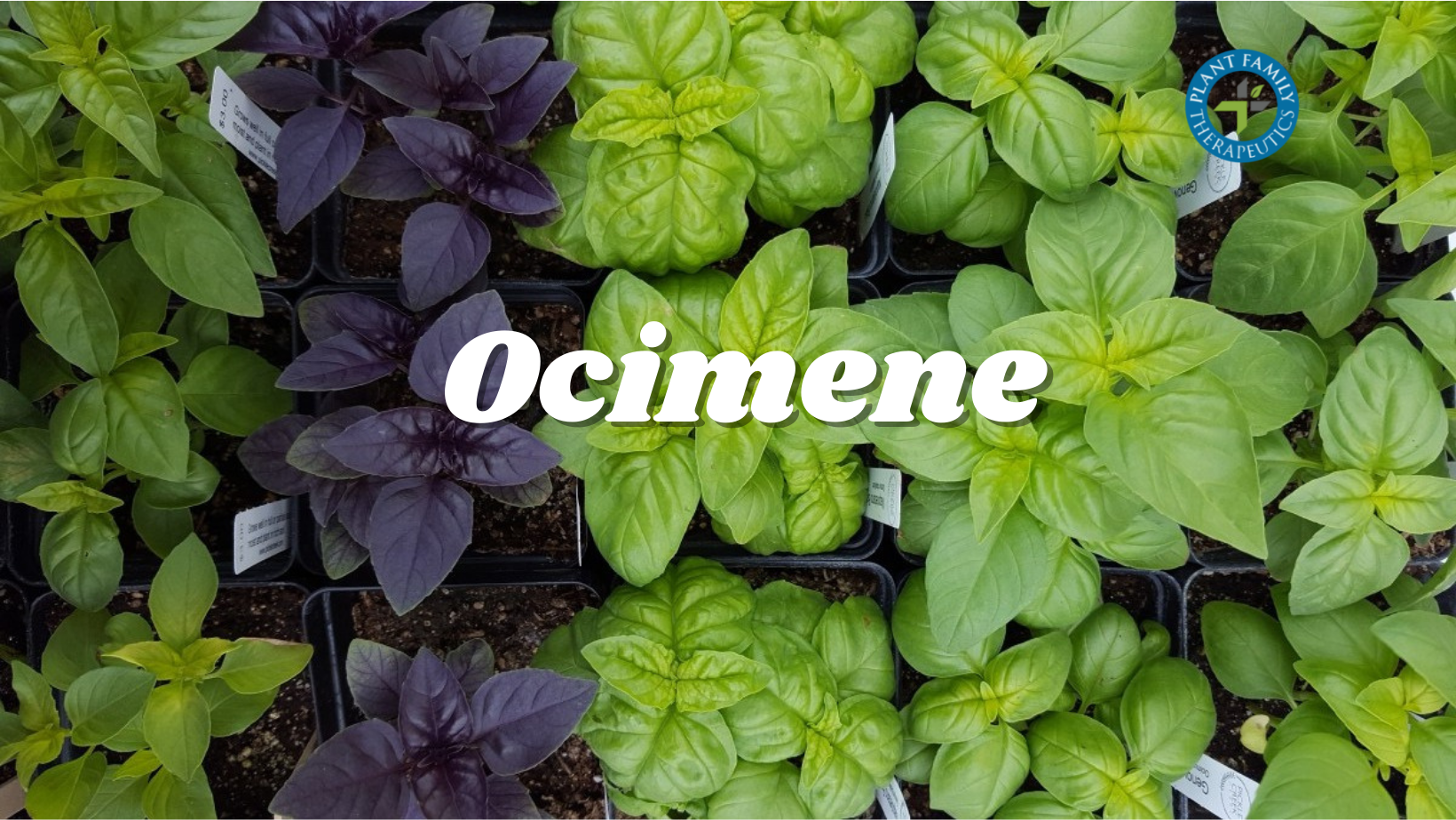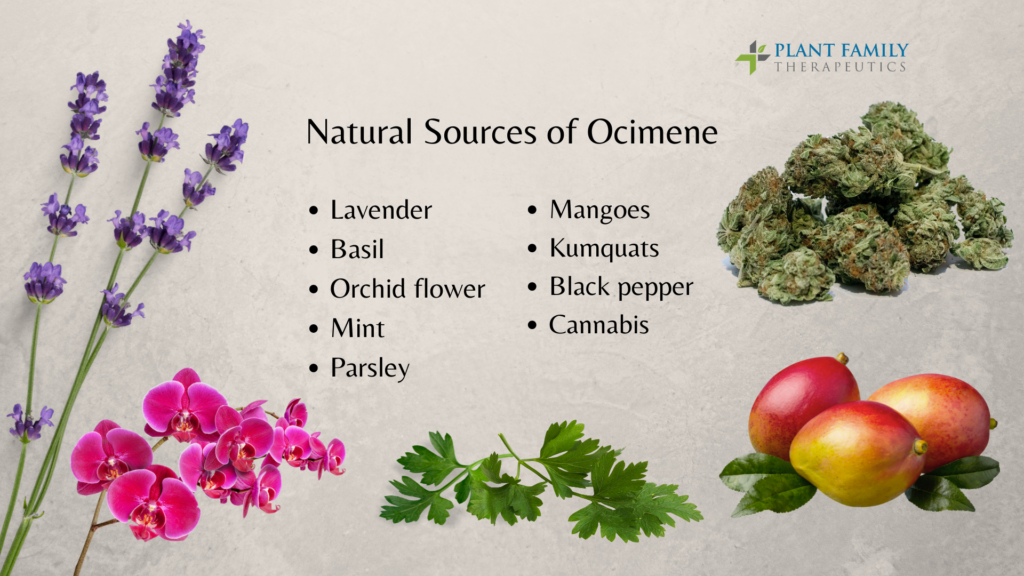This website requires you to be 21 years or older to enter. Please confirm your age below to continue.

In the last segment of the terpene series, I discussed Myrcene, a powerful relaxant and sedative. Here I will talk about Ocimene and its many therapeutic benefits.
What is Ocimene?
Ocimene (ah-sigh-meen) is an acyclic monoterpene that is found in three different forms, a-oicmene, cis-b-ocimene, and trans-b-ocimene and is derived from the Greek word “Ocimum,“ which means basil. This terpene offers many medicinal and therapeutic uses for its uplifting effects, anti-convulsant, anti-inflammatory, anti-viral, and anti-fungal properties.
Ocimene is one of the most common monoterpenes found in nature. Although its profile is not predominantly herbal, ocimene displays a warm woody with an almost floral sweetness aroma.
This terpene contributes significantly to the floral odor of various plant species, including the scent of orchid and snapdragon flowers. Ocimene is also a pheromone involved in social regulation in the honey-bee colony.
Medical benefits of Ocimene
Ocimene is known for its antifungal, antiviral, and anti-inflammatory effects, but this terpene works best when combined with other terpenes such as a-pinene and myrcene. The synergy between ocimene and other terpenes is known as the entourage effect. This is also the reason why many people go for whole-plant extract compared to isolate.
Antiviral Effect
In a report published in Chemistry & Biodiversity, ocimene was one of seven essential oils analyzed. The study looked at the influence of essential oils on SARS-CoV, a corona virus that can cause severe acute respiratory syndrome, as well as the herpes simplex virus (HSV-1). According to the study, Laurus nobilis oil (Bay tree or laurel), which includes ocimene, a-pinene, cineole, and b-pinene, has an antiviral impact against the herpes simplex virus (HSV-1).
Antifungal Effect
A 2015 study published in the Journal of Natural Medicines investigated the antifungal effects of Angelica species essential oil against Candida and other species. This essential oil’s two primary constituents are ocimene and a-pinene. The study evaluated the effects of these components against relevant yeasts and molds. According to the findings of the study, ocimene, when coupled with other components, may have antifungal properties, notably against cryptococcosis (a fungus in the lungs) and dermatophytosis (ringworm).
Plants that contain exceptionally high levels of ocimene are traditionally used in the Middle East as a preservative to extend the shelf life of dairy products. Research indicates that tarragon, which is very high in ocimene, has anti-bacterial and anti-fungal properties, giving it a similar ability to reduce food spoilage.
Anti-Inflammatory Properties
A 2013 study published in the journal Food and Chemical Toxicology looked at the antifungal, antioxidant, and anti-inflammatory activities of the essential oil Oenanthe crocata L (Water hemlock-dropwort). Ocimene is one of the main terpenes of this essential oil. Researchers noted that ocimene showed strong anti-inflammatory, antifungal, and antioxidant properties. And like the study from the Journal of Natural Medicines, was found to be useful especially against dermatophytes (ringworm).
Potential Anti-Oxidative Properties
In another 2013 study, which looked into the antioxidative properties of essential oil from black pepper. Researchers revealed that ocimene is one of the main terpenes of black pepper essential oil (also high in caryophyllene), together with a and b-pinene. The authors of the study revealed that the oil showed antioxidative properties and discovered that it could manage or prevent type-2 diabetes and hypertension.
Acts as a Decongestant
Monoterpenes, such as ocimene, are utilized as a decongestant in aromatherapy because they are mucous membrane tonics. Aromatherapy using monoterpenes may alleviate nasal and other mucous membrane discomforts.
One of ocimene’s many therapeutic benefits is as a decongestant and expectorant. Anecdotal evidence indicates that ocimene helps clear airways and improve respiration when smoked or vaped—but it can induce coughing in the process, so patients that wish to avoid coughing should avoid strains high in ocimene.
Cognitive Effects
Ocimene is generally considered a stimulant. Interestingly, researchers have found that ocimene tends to be present in the more uplifting, sativa-dominant strains – a finding consistent with our test results and anecdotal evidence.

Where to find
Ocimene produces an energetic effect in cannabis and is usually found in sativa strains. It shouldn’t be too hard to find strains high in ocimene. To identify strains rich in ocimene, use your nose or select strains that are listed as having a sweet, woodsy aroma similar to mint. Terpene levels vary from harvest to harvest, but some strains consistently produce high levels. Strains that are often high in ocimene here in Arkansas are Strawberry Cough, Super Lemon Haze, Green Crack, Chernobyl, and Sour Diesel.
Boiling Point
Ocimene has an extremely low boiling point of 66°C/150°F – so the best way to take advantage of its benefits is by using a customizable temperature vaporizer.
Final Thoughts
These are just some of the potential benefits discovered in various studies. With more studies being done on terpenes we can expect to see more practical uses of the ocimene terpene.
Something extra
So far, I have discussed Caryophyllene, Myrcene, and now Ocimene. All three are pain relivers, anti-inflammatories, and protectants against various other ailments. Here is a tasty cannabis infused treat that combines the three terpenes as well as other great benefits including an anti-toxin (removes harmful toxins from your body), pineapple-mango salsa.
References
Cavaleiro, C., Salgueiro, L., Gonçalves, M. J., Hrimpeng, K., Pinto, J., & Pinto, E. (2015). Antifungal activity of the essential oil of Angelica major against Candida, Cryptococcus, Aspergillus and dermatophyte species. Journal of natural medicines, 69(2), 241–248. https://doi.org/10.1007/s11418-014-0884-2
Golfakhrabadi, F., Khanavi, M., Ostad, S. N., Saeidnia, S., Vatandoost, H., Abai, M. R., Hafizi, M., Yousefbeyk, F., Rad, Y. R., Baghenegadian, A., & Ardekani, M. R. (2014). Biological Activities and Composition of Ferulago carduchorum Essential Oil. Journal of arthropod-borne diseases, 9(1), 104–115. https://www.ncbi.nlm.nih.gov/pmc/articles/PMC4478411/
Hassanzaadeh, K., Najaran, Z., Nasery, M., & Emami, S. (2016). Tarragon Oils. Victor R. Preedy Department of Nutrition and Dietetics, King’s College London, London, UK. Essential Oils in Food Preservation, Flavor and Safety. Elsevier; 813-817 https://doi.org/10.1016/B978-0-12-416641-7.00092-4
Loizzo, M. R., Saab, A. M., Tundis, R., Statti, G. A., Menichini, F., Lampronti, I., Gambari, R., Cinatl, J., & Doerr, H. W. (2008). Phytochemical analysis and in vitro antiviral activities of the essential oils of seven Lebanon species. Chemistry & biodiversity, 5(3), 461–470. https://doi.org/10.1002/cbdv.200890045
Michelozzi, M., Grassi, G., & Casano, S. (2011). Variations in Terpene Profiles of Different Strains of Cannabis sativa L. Retrieved , June 4, 2021, from https://www.fundacion-canna.es/en/variations-terpene-profiles-different-strains-cannabis-sativa-l
Oboh, G., Ademosun, A. O., Odubanjo, O. V., & Akinbola, I. A. (2013). Antioxidative properties and inhibition of key enzymes relevant to type-2 diabetes and hypertension by essential oils from black pepper. Advances in pharmacological sciences, 2013, 926047. https://doi.org/10.1155/2013/926047
Russo, E. B., & Marcu, J. (2017). Cannabis Pharmacology: The Usual Suspects and a Few Promising Leads. Advances in pharmacology (San Diego, Calif.), 80, 67–134. https://doi.org/10.1016/bs.apha.2017.03.004
Sayyah, M., Nadjafnia, L., & Kamalinejad, M. (2004). Anticonvulsant activity and chemical composition of Artemisia dracunculus L. essential oil. Journal of ethnopharmacology, 94(2-3), 283–287. https://doi.org/10.1016/j.jep.2004.05.021
Valente, J., Zuzarte, M., Gonçalves, M. J., Lopes, M. C., Cavaleiro, C., Salgueiro, L., & Cruz, M. T. (2013). Antifungal, antioxidant and anti-inflammatory activities of Oenanthe crocata L. essential oil. Food and chemical toxicology : an international journal published for the British Industrial Biological Research Association, 62, 349–354. https://doi.org/10.1016/j.fct.2013.08.083